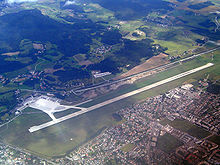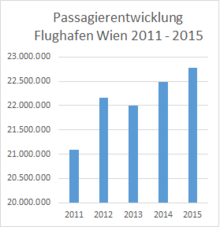List of commercial airports in Austria
The list of commercial airports in Austria contains all Austrian airports served by national and international airlines .
Explanation
- Name of the airport: Provides the name of the airport and any additional names.
- IATA code : The code consists of a combination of three Latin letters and is used to clearly identify the individual commercial airports. The IATA code is issued by the International Air Transport Association (IATA).
- ICAO code : The ICAO code is issued by the International Civil Aviation Organization and consists of a unique combination of four Latin letters. The first two digits LO standfor Austria, while thethirddigit W designates an international airport. The fourth letter is usually identical to the first letter of the geogr. Place to which the airfield is assigned, with a few exceptions.
- Opening: states the year in which the airport was opened at the current location.
-
Passenger numbers: Indicates the total number of passengers at the airport for the respective year.
This includes regular services, package tours, commercial traffic, commercial traffic and other traffic. In addition, there is non-commercial traffic, such as factory traffic and non-commercial traffic. - Passenger Capacity: Indicates the current capacity of the airport in passengers (PAX) per year.
-
Flight movements: Shows the total flight movements of the airport for the respective year.
This includes regular services, package tours, commercial traffic, commercial traffic and other traffic. In addition, there is non-commercial traffic, such as factory traffic and non-commercial traffic. - Freight: Indicates the total freight handled at the airport, including airmail, in tons for the respective year.
-
SLB: SLB stands for runways .
- Direction: The direction of approach and departure to the respective runway. The numbers result from the orientation of the orbit to the magnetic north , rounded up or down to the nearest full decimal and then shortened by the last digit (for example, 258 ° becomes runway 26). If an airport has two parallel runways with the same magnetic orientation, the runway designation is usually extended by the suffix “L” (left) or “R” (right) - seen from the approach direction.
-
Surface : The surface properties of the runways. Due to the necessary load-bearing capacity, asphalt or concrete is usually used , at least in installations with fixed-wing aircraft .
Asphalt has the advantage that it can be applied during repair work during the night and the slope is available again at the beginning of the day. Concrete, on the other hand, has a higher load-bearing capacity and service life. Occasionally there is also a mixture of asphalt and concrete. In this case the main material used is indicated. Antiskid is an additional surface that can be applied to the track to increase the braking effect and at the same time minimize the risk of slipping.
The following abbreviations are used in the list: -
Size: Describes the dimensions of the corresponding slope (length × width) in meters. The mandatory specification of runway dimensions in official publications is always in feet , the unit of measurement used in aviation for short distances on the ground.
In order to make it easier to understand for readers with no technical reference, this information is often converted into meters in reference works in countries with the metric system . Conversion and rounding occasionally result in slight differences between the various sources. The information given here comes directly from official publications, if available, or has been converted from such publications with a factor of 0.305.
Commercial airports
| Airport name |
IATA code |
ICAO code |
Eröff- voltage |
Pass. Capacity |
Start-and runway | ||
|---|---|---|---|---|---|---|---|
| direction | Topping | size | |||||
| Airport Wien-Schwechat | VIE | LOWW | 1938 | 30,000,000 | 11/29 16/34 |
T | 3,500 × 45 3,600 × 45 |
| Salzburg Airport | SZG | LOWS | 1926 | 1,870,000 | 15/33 | B. | 2,750 × 45 |
| Innsbruck airport | INN | LOWI | 1948 | nv | 08/26 | A. | 2,000 × 45 |
| Graz Airport | GRZ | LOWG | 1913 | 1,500,000 | 17L / 35R 17C / 35C 17R / 35L |
G A G |
640 × 30 3,000 × 45 760 × 25 |
| Linz Airport | LNZ | LOWL | 1955 | nv | 08/26 | A. | 3,000 × 60 |
| Klagenfurt Airport | KLU | LOWK | 1925 | 950,000 | 10R / 28L 10L / 28R |
G B |
740 × 27 2,720 × 45 |
Passenger numbers 2011–2017
| Airport name | 2011 | 2012 | 2013 | 2014 | 2015 | 2016 | 2017 |
| Airport Wien-Schwechat | 21.096.398 | 22.165.733 | 21,999,820 | 22,482,884 | 22,774,878 | 23,350,452 | 24,392,129 |
| Salzburg Airport | 1,700,983 | 1,666,487 | 1,662,834 | 1,819,520 | 1,828,309 | 1,739,288 | 1,890,164 |
| Innsbruck airport | 997.020 | 930.850 | 981.118 | 991.356 | 1.001.255 | 1,006,696 | 1,092,547 |
| Graz Airport | 976.414 | 930.448 | 881,565 | 897.171 | 963.187 | 981.706 | 958.848 |
| Linz Airport | 679.220 | 623.383 | 549.961 | 561.295 | 529.846 | 435,468 | 402.007 |
| Klagenfurt Airport | 376.198 | 280.434 | 259.336 | 225,842 | 228.922 | 194,989 | 218.281 |
Flight movements 2011–2017
| Airport name | 2011 | 2012 | 2013 | 2014 | 2015 | 2016 | 2017 |
| Airport Wien-Schwechat | 246.003 | 244,650 | 231.177 | 230.781 | 226.811 | 226.395 | 224,568 |
| Salzburg Airport | 59,817 | 55.052 | 56,200 | 55,301 | 58,433 | 54,046 | 57,577 |
| Innsbruck airport | 13,505 | 11,877 | 11,535 | 11,687 | 11,856 | 11,813 | 12,040 |
| Graz Airport | 15,866 | 14,500 | 14,778 | 14,256 | 15,352 | 14,332 | 14,271 |
| Linz Airport | 10,669 | 10,894 | 10,227 | 10,433 | 8,361 | 7,390 | 6,890 |
| Klagenfurt Airport | 6,911 | 5,157 | 4,696 | 4,438 | 4,465 | 3,952 | 4,337 |
Air freight in [t] 2011–2015
| Airport name | 2011 | 2012 | 2013 | 2014 | 2015 |
| Airport Wien-Schwechat | 232.377 | 210.207 | 211,927 | 239,695 | 236.024 |
| Salzburg Airport | 169 | 214 | 182 | 201 | 213 |
| Innsbruck airport | 372 | 275 | 239 | 184 | 139 |
| Graz Airport | 222 | 1,442 | 312 | 382 | 384 |
| Linz Airport | 8,350 | 8,292 | 9,531 | 10,988 | 10.111 |
| Klagenfurt Airport | <1 | <1 | <1 | <1 | 0 |
See also
- List of commercial airports in Germany
- List of Austrian airfields
- List of the largest commercial airports
- List of IATA airport codes
- List of commercial airports in Europe
Individual evidence
- ↑ http://www.statistik.at/web_de/statistiken/verkehr/luftfahrt/habenverkehr/022539.html
- ↑ http://www.statistik.at/web_de/statistiken/verkehr/luftfahrt/fracht-_und_postverkehr/022538.html
- ↑ STATISTICS AUSTRIA: Passenger traffic. In: www.statistik.at. Retrieved August 20, 2016 .
- ↑ Aviation. Retrieved July 28, 2020 .
- ↑ STATISTICS AUSTRIA: Passenger traffic. In: www.statistik.at. Retrieved August 20, 2016 .
- ↑ STATISTICS AUSTRIA: Freight and mail traffic. In: www.statistik.at. Retrieved August 20, 2016 .






